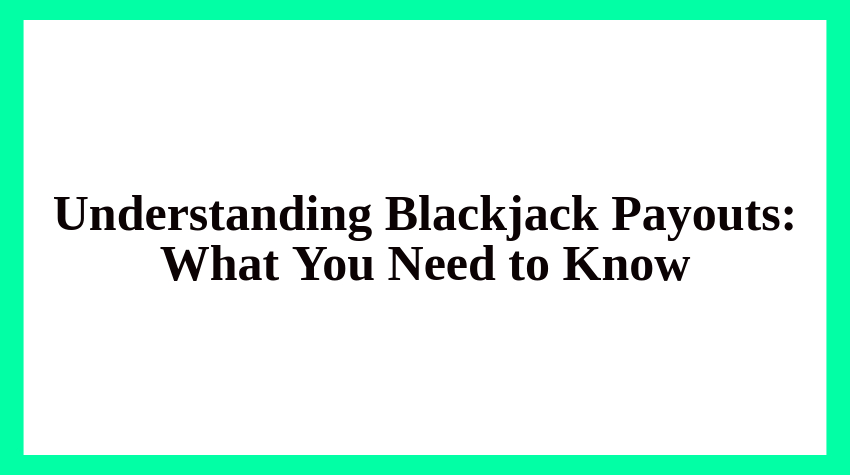Blackjack is one of the most exciting and strategic casino games, combining elements of skill and chance. Whether you’re playing at a land-based casino or enjoying the thrill of online Blackjack, understanding how payouts work is crucial for making informed betting decisions.
If you’re unfamiliar with the basics of the game, it’s helpful to first explore what Blackjack is and how the game functions. This foundational understanding will provide you with a solid foundation to understand how payouts work and how to make the most of your Blackjack experience. Once you’re comfortable with the basics, we’ll break down how Blackjack payouts work, including the different types of bets, side bets, and the payout for a Blackjack hand versus a regular win.
By the end of this article, you will have the knowledge to make the most of your Blackjack experience, whether you’re a beginner or a seasoned player.
The Basics of Blackjack Payouts
What Does “Payout” Mean in Blackjack?
In Blackjack, a payout refers to the amount you win based on your bet and the outcome of your hand. When you win a hand, the casino calculates your payout by multiplying your bet by a specific ratio, which varies depending on the type of win. For instance, winning a regular hand might give you even money (1:1), while hitting a Blackjack (an Ace and a 10-value card) might give you a higher payout.
- Regular Payout: This is the payout for a standard win, where you beat the dealer with a higher hand value without going over 21.
- Blackjack Payout: If you have a Blackjack (Ace and a 10-value card) and the dealer doesn’t have one, you receive a special payout.
Types of Blackjack Bets and Their Payouts
In addition to the standard win, Blackjack offers various betting options that affect your payouts. These include side bets, insurance, and other advanced bets, all of which carry different payout structures.
- Player Bet: A standard bet where you bet on your hand winning. This is typically paid at 1:1 if you win.
- Blackjack Bet: When you get a Blackjack, you win 1.5:1 on your bet, which means you get a 50% bonus on your wager.
- Insurance Bet: A side bet that you can place when the dealer shows an Ace. The payout is 2:1 if the dealer has a Blackjack, but it is usually considered a high-risk bet.
Understanding Regular Wins vs. Blackjack Wins
Regular Hand Payouts (1:1)
When you play Blackjack, the most common type of win is a regular hand win. This occurs when your hand’s total value is higher than the dealer’s hand without exceeding 21.
- Standard Win: If you have a hand value of 18 and the dealer has a hand value of 17 or lower (without busting), you win. In this case, your payout will be 1:1, meaning you receive your original bet back, plus the same amount in winnings.
- Example: If you bet ¥1,000 and win, you receive ¥1,000 in winnings plus your original bet, giving you a total of ¥2,000.
Blackjack Win Payouts (3:2)
A Blackjack is a special type of win. It occurs when you have an Ace and a 10-point card (10, Jack, Queen, or King) as your first two cards. This is considered the best possible hand in Blackjack.
- Blackjack Win: When you hit a Blackjack and the dealer does not, you win 3:2 on your bet, meaning you receive 1.5 times your original wager.
- Example: If you bet ¥1,000 and hit a Blackjack, you will receive ¥1,500 in winnings, plus your original ¥1,000 bet, totaling ¥2,500.
Side Bets in Blackjack and Their Payouts
What Are Side Bets in Blackjack?
Side bets are additional bets that you can place in Blackjack, typically based on specific card combinations or events. These bets are often optional and are separate from the main wager. While side bets offer higher payouts, they come with a higher house edge, making them riskier but potentially more rewarding.
- Insurance: As mentioned earlier, you can place an insurance side bet when the dealer shows an Ace. With this bet, you’re wagering that the dealer has a Blackjack. The payout for a winning insurance bet is 2:1.
- Perfect Pairs: A side bet where you wager that your first two cards will be a pair. If you win, payouts vary depending on the type of pair (e.g., mixed pair, colored pair, or perfect pair). For example, a perfect pair pays 25:1, a colored pair pays 12:1, and a mixed pair pays 6:1.
Other Common Blackjack Side Bets
- 21+3: A side bet based on the combination of your first two cards and the dealer’s upcard. This bet pays out if you have a flush, straight, three-of-a-kind, or straight flush. The payout can range from 9:1 to 100:1, depending on the combination.
- Lucky Ladies: This side bet pays out if the total value of your first two cards equals 20. A winning hand of two Queen of Hearts pays 200:1, while other combinations may offer lower payouts.
How House Edge Affects Blackjack Payouts?
What is the House Edge in Blackjack?
The house edge refers to the statistical advantage that the casino has over the player. It is usually expressed as a percentage of the total amount wagered. In Blackjack, the house edge varies based on the rules of the game, the type of Blackjack played, and the player’s strategy.
- House Edge and Payouts: A lower house edge means that players are likely to win more in the long run. Games with fewer decks or more favorable rules (e.g., player Blackjack pays 3:2) offer better odds for players.
- Impact of Side Bets: Side bets typically have a higher house edge. For example, while the house edge for a standard Blackjack game might be around 0.5%, the house edge for side bets like Perfect Pairs can be as high as 4-5%.
Strategies to Reduce the House Edge
To reduce the house edge and increase your chances of winning, it’s important to follow basic Blackjack strategies, such as:
- Use Basic Strategy: Basic strategy involves making the best decision based on your hand and the dealer’s upcard. By following this strategy, you can lower the house edge and improve your odds of winning.
- Avoid Insurance: While insurance may seem like a good bet, it is typically not favorable for players. The house edge for insurance is quite high, so it’s generally recommended to avoid this side bet.
Special Blackjack Payouts and Variants
21+3 and Other Side Bets
The 21+3 side bet, which combines your first two cards with the dealer’s upcard, offers exciting opportunities for larger payouts. While it has a higher house edge, the potential for winning big payouts (up to 100:1) makes it a thrilling option for some players.
- Example Payouts: If your first two cards and the dealer’s upcard make a straight flush, you could win a payout of 100:1, offering a huge reward for a rare combination.
- Other Payout Variants: Some casinos offer additional side bets that pay out for unusual card combinations, such as Flush, Straight, or Three-of-a-Kind. These bets typically pay out high rewards but come with a higher house edge.
Blackjack Payout Variants
In some Blackjack variants, the payout for a Blackjack might differ. For example, some online casinos or land-based casinos may offer a payout of 6:5 for a Blackjack instead of the standard 3:2. This increases the house edge, so it’s important to look for tables that offer the higher 3:2 payout.
Conclusion: Understanding Blackjack Payouts for Smarter Play
Blackjack is a game of skill, strategy, and knowledge. Understanding how payouts work—whether it’s a regular win, a Blackjack, or a side bet—can significantly improve your chances of success at the table. By recognizing the different payouts and how side bets work, you can make smarter decisions and maximize your winnings.
Remember, the key to success in Blackjack isn’t just about luck—it’s about knowing the odds, understanding the payouts, and applying solid strategy. Whether you’re new to the game or looking to refine your skills, mastering Blackjack payouts is an essential step in becoming a more confident and successful player.
If you’re ready to apply your knowledge and start playing smarter, head over to Casino Savvy, where you can find expert strategies, tips, and resources to elevate your Blackjack game!









Comments